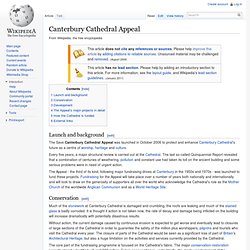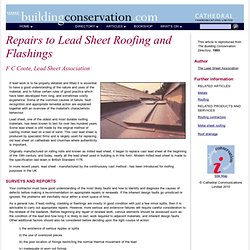

Elk Grove Civic Center Zaha Hadid Architects. Canterbury Cathedral Appeal. Launch and background[edit] The Save Canterbury Cathedral Appeal was launched in October 2006 to protect and enhance Canterbury Cathedral's future as a centre of worship, heritage and culture.

Every five years, a major structural review is carried out at the Cathedral. Www.britishlead.co.uk/downloads/brochure.pdf. Lead. Characteristics A sample of freshly solidified lead (from molten state) Lead is a bright and silvery metal with a very slight shade of blue in a dry atmosphere. Upon contact with air, it begins to tarnish by forming a complex mixture of compounds depending on the conditions. The color of the compounds can vary. The tarnish layer can contain significant amounts of carbonates and hydroxycarbonates.[2][3] Its characteristic properties include high density, softness, ductility and malleability, poor electrical conductivity compared to other metals, high resistance to corrosion, and ability to react with organic chemicals. Various traces of other metals change its properties significantly: the addition of small amounts of antimony or copper to lead increases the alloy's hardness and improves corrosion resistance from sulfuric acid.
ANTI—Journey to Architecture: Day 6 (and beyond) DAY 6—October 26 Raimund and I agreed that it was inconceivable we would not visit the last church designed by Le Corbusier at Firminy-Vert, only a two hour drive south from Roanne, and then make the day-long dash across France and Switzerland to Zurich, where we would catch our flight to New York the next day. Daniel Libeskind. Daniel Libeskind (born May 12, 1946) is a Polish architect, artist, and set designer of Polish Jewish descent. Libeskind founded Studio Daniel Libeskind in 1989 with his wife, Nina, and is its principal design architect.[1] His buildings include the Jewish Museum in Berlin, Germany, the extension to the Denver Art Museum in the United States, the Grand Canal Theatre in Dublin, the Imperial War Museum North in Greater Manchester, England, the Michael Lee-Chin Crystal at the Royal Ontario Museum in Toronto, Canada, the Felix Nussbaum Haus in Osnabrück, Germany, the Danish Jewish Museum in Copenhagen, Denmark, and the Wohl Centre at the Bar-Ilan University in Ramat-Gan, Israel.[2] His portfolio also includes several residential projects.
Personal life[edit] Kurt Schwitters. Kurt Hermann Eduard Karl Julius Schwitters (20 June 1887 – 8 January 1948) was a German painter who was born in Hanover, Germany. Early influences and the beginnings of Merz, 1887-1922[edit] Das Undbild, 1919, Staatsgalerie Stuttgart Hanover[edit] Kurt Schwitters was born on 20 June 1887, at No.2 Rumannstraße,[1][2] Hanover, the only child of Edward Schwitters and his wife Henriette (née Beckemeyer).
His parents were proprietors of a ladies' clothes shop. After studying art at the Dresden Academy alongside Otto Dix and George Grosz, (although Schwitters seems to have been unaware of their work, or indeed of contemporary Dresden artists Die Brücke[3]), 1909–15, Schwitters returned to Hanover and started his artistic career as a post-impressionist. Schwitters spent the last one and half years of the war working as a technical draftsman in a factory just outside Hanover. He married his cousin Helma Fischer on 5 October 1915. "In the war, things were in terrible turmoil. Der Sturm[edit] Tate Papers - Towards Anarchitecture: Gordon Matta-Clark And Le Corbusier.
Deconstructivism. Deconstructivism is a development of postmodern architecture that began in the late 1980s. It is influenced by the theory of "Deconstruction", which is a form of semiotic analysis. The Editors. InShare0. Architecture parlante. Architecture parlante (“speaking architecture”) is architecture that explains its own function or identity. The phrase was originally associated with Claude Nicolas Ledoux, and was extended to other Paris-trained architects of the Revolutionary period, Étienne-Louis Boullée, and Jean-Jacques Lequeu.[1] Emil Kaufmann traced its first use to an anonymous critical essay with Ledoux's work as the subject, written for Magasin Pittoresque in 1852, and entitled "Etudes d'architecture en France".[2] In Ledoux's unbuilt plans for the salt-producing town of Chaux, the hoop-makers' houses are shaped like barrels, the river inspector's house straddles the river, and an enormous brothel takes the shape of an erect phallus.
Nonce orders[edit] The Self-Consuming Barbecue Pavilion. Note: This is a guest post by Nicola Twilley, originally published on Edible Geography. In a fantastic hybrid of edible architecture and temporary summer pavilion, architect Caroline O'Donnell has proposed Bloodline, a free-standing, self-consuming grilling shelter. [Image: Sectional model through the preparation bench, Bloodline pavilion by Caroline O'Donnell; Bloodline is supported by the Akademie Schloss Solitude]. The Canterbury Gift > Lead Tile - Individuals. Www.thecanterburygift.com/pdf/Sponsor a lead tile.pdf. Www.arcorepoxy.com/PDF.DATA.MSDS/news/understanding_how_metals_corrode.pdf. Repairs to Lead Sheet Roofing and Flashings.
If lead work is to be properly detailed and fitted it is essential to have a good understanding of the nature and uses of the material, and to follow certain rules of good practice which have been developed from long, and sometimes costly experience.

Some of the common causes of failure, fault recognition and appropriate remedial action are explained together with an overview of the material's characteristic behaviour. Lead sheet, one of the oldest and most durable roofing materials, has been known to last for over two hundred years. Some lead sheet is still made by the original method of casting molten lead on a bed of sand. This cast lead sheet is produced by specialist firms and is largely used for replacing old lead sheet on cathedrals and churches where authenticity is important.